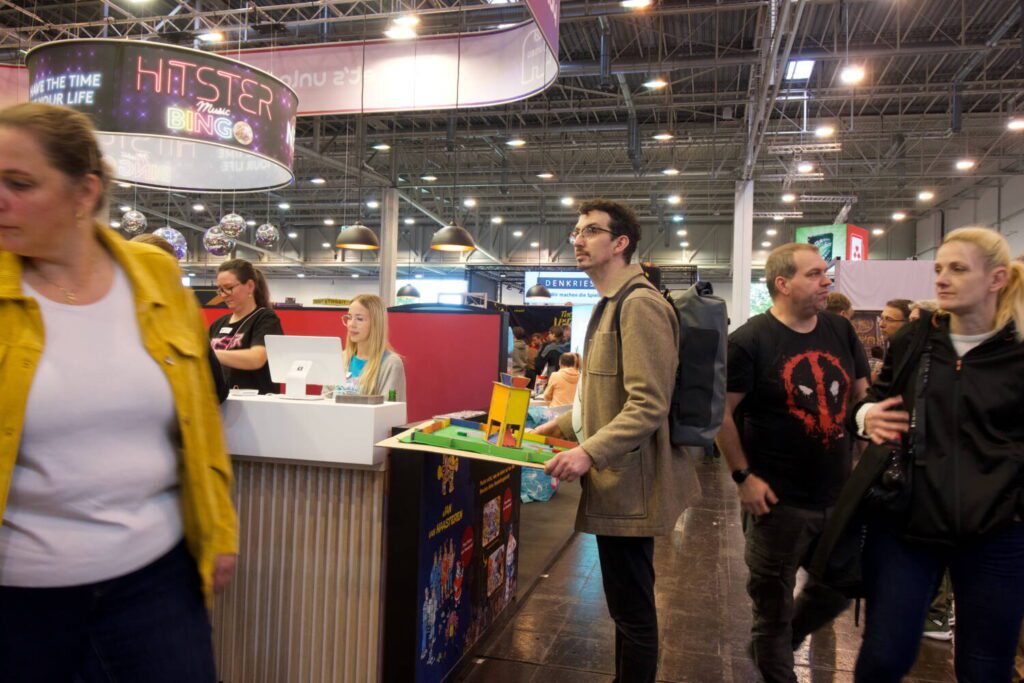 Jim Williams cannot help but make an immediate impression. For one thing, he’s tall. Not so tall as to be off-putting, but tall enough that the human instinct for self-preservation knows better than to ignore whatever just walked up. There is also something of the absent-minded professor about him. While Mr. Williams seldom crosses the line into outwardly disheveled—that would necessitate the presence of food stains, poor clothing, or loose leafs of paper sticking out the top of his bag—one would never go so far as to describe him as entirely sheveled either. The dark curls do a lot of the heavy lifting there, as does the 5 o’clock shadow that habitually shows up for work early.
Jim Williams cannot help but make an immediate impression. For one thing, he’s tall. Not so tall as to be off-putting, but tall enough that the human instinct for self-preservation knows better than to ignore whatever just walked up. There is also something of the absent-minded professor about him. While Mr. Williams seldom crosses the line into outwardly disheveled—that would necessitate the presence of food stains, poor clothing, or loose leafs of paper sticking out the top of his bag—one would never go so far as to describe him as entirely sheveled either. The dark curls do a lot of the heavy lifting there, as does the 5 o’clock shadow that habitually shows up for work early.
Most important of all in noticing and remembering Jim Williams is Jim Williams himself. The Englishman approaches every interaction with a level of sincerity, enthusiasm, and engagement that is rare. When Jim talks to you, you cannot help but feel that he is speaking to you, and you alone. He seldom checks his phone and rarely looks about the room. Like many people who are easily distracted, his attention is absolute when he applies it. Speaking with Jim over food in a crowded courtyard at Spiel 2024, we might as well have been the only two people in the entirety of the city of Essen.
We weren’t, of course. There were 204,998 other people in attendance at Spiel 2024, the largest attendance in the convention’s history. While the majority of punters attend Spiel to experience board games as consumers, Jim didn’t have time for that. He was a man on a mission. Jim had flown over from London for the day to try and rustle up some pitch meetings.
This was, by his own admission, rather last minute. What with one thing and another going on in his life, he didn’t have time to organize. He’d originally planned on coming to Essen for multiple days, then thought he mightn’t come at all, but as is often the case with Jim, impulse won out. He decided to come for the Saturday.
How impulsive is impulsive, you ask? He realized Friday evening that he didn’t have a ticket. Normally that wouldn’t be a huge problem, but 2024 marks the first time in Spiel’s history that the convention sold entirely out. There were no tickets to be had. Fortunately, with the help of some friends in the industry, Jim was able to find an abandoned exhibitor’s badge. So much the better for us, since that meant we could meet in Hall 6 before the doors had opened to the general public. “Yeah!, so. Here we are,” he said, taking it all in. “I’ve managed to get two appointments for this afternoon, so until then I thought I might pop around and see if I can manage anything with other publishers.”
He had brought four games with him, all of them either party or family games. “I’ve decided to focus on lighter games for the moment,” he told me. “I have loads of more complex ideas that I’m excited to get to, but for now I want to focus on really getting these right.” Without being too specific—it seems best to keep nascent ideas to themselves—the games represented a good spread. Jim was going to spend the day pitching a dexterity game about food, a family game about pigeons, a party game centered on impressions, and a word game.
We made a quick stop over at the shipping booth so I could send some games home. Jim’s mind was already furiously at work. “You know,” he said as he eyed up a box, “this would make a good surface…I wonder…” He changed his focus to the man behind the counter. “Do you have a knife?” The side of a box became, with some alterations and a bit of tape, a base upon which to mount the pigeon game. In its current prototypical form, the board is a felted green mat, in the center of which stands a large cardboard tower. Jim mounted the mat, placed the tower, set up some cardboard boundaries, and went about distributing components across the board. He then picked it up from opposite edges, testing the weight and balance.
After a moment’s consideration, he moved two cubes about a quarter of an inch to the right. “There we go,” he said, more to himself than anyone else. “That’ll do nicely. Shall we?”
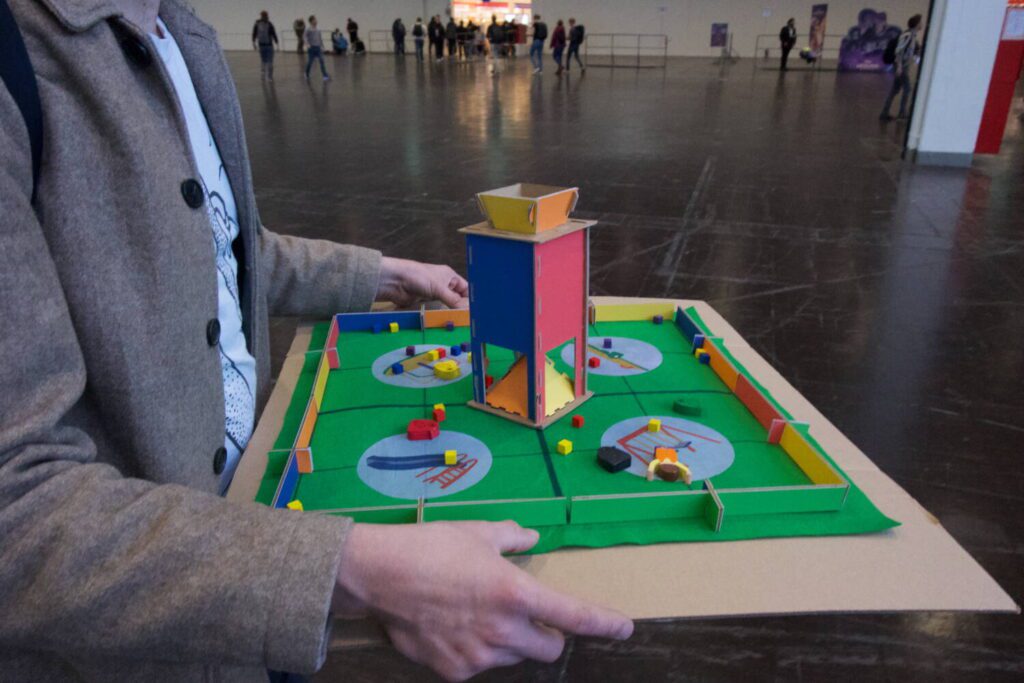
* * * * *
Whatever impracticalities you suspect may present themselves while carrying a 2’ x 2’ piece of horizontal cardboard through the halls of Spiel, know that you are, to my extreme surprise, more wrong than right. “It’s almost easier, isn’t it,” Jim remarked. “People by and large seem to get out of the way.” It was true. A bit of Moses and the Red Sea, my friend Jim walking through the crowds with his game.
There was some top-flight gawking, too, none of which I managed to capture with my camera. The looks trended towards curiosity about the game, but there was annoyance at someone carrying something so large through a crowded area, delight at seeing something unusual, and bemusement at the spectacle of this veruchte Änglischer. (Enough time in Europe and you learn not to make assumptions about where people are from based solely on their appearance, but Jim is most assuredly Änglischer.)
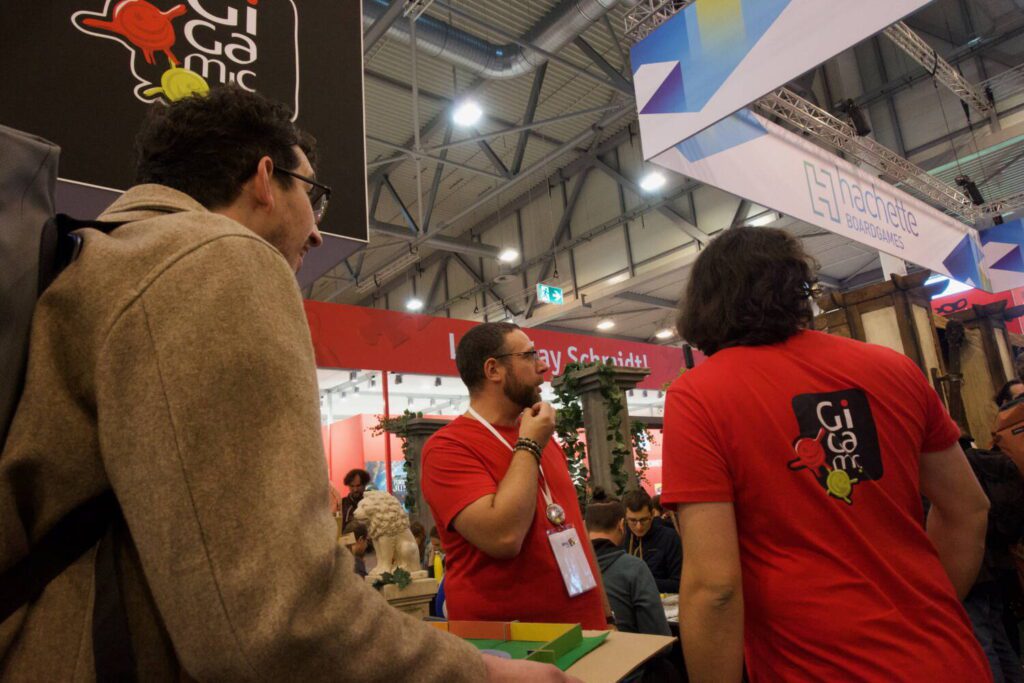
Much of the early day consisted of rejection, but only in the sense that calendars were full. We settled into an easy pattern. Jim, who I will remind you was carrying a horizontal 2’ x 2’ board with a foot-tall cardboard tower on it, would walk up to a booth. “Hullo,” he would chime. “I’m in for the day to pitch some games, and have a few meetings this afternoon, so in the meantime I’m popping around from booth to booth to see what pitches I can scare up.” The wisdom of this struck me immediately. To say—truthfully, mind—that he had appointments in the afternoon put people at ease, reassuring them that he was a professional and not some loon walking around the convention hall with nothing but a game and a dream. Despite both appearances and, one could argue, the truth.
“Is there any chance you have anyone at the booth who is available to hear some pitches today?” Typically, they would check the calendar, or grab the appropriate party, or immediately say that the calendar was full, but this was to be expected, and Jim’s spirits never faltered. “Where else should we go?” One publisher did have space for a 6:30 pitch, which fit in perfectly with Jim’s already-scheduled 4:30 and 5:30 appointments. Tremendous.
“Where else should we go?” became a bit of a mantra, often said as Jim opened up an app on his phone where he kept exhaustive lists of publishers, the games he’d submitted to them, the games they’re known for publishing, and the status of all those submissions. Even if the amount of organization for Saturday itself wasn’t necessarily ideal, the general level of ongoing organization Jim practices is exemplary. That sort of dedication and focus is what allows for whims like Saturday to be something of substance rather than a complete lark.
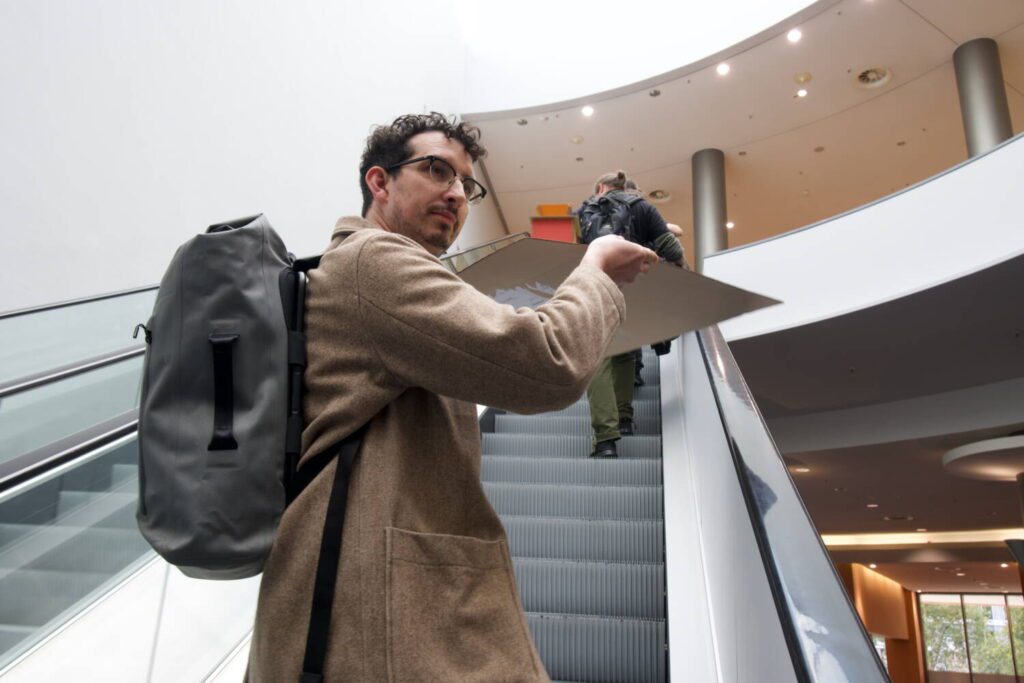
One publisher sent us to their space up on the second floor. Jim had the good fortune of showing up right when another appointment did not. “Sure, yeah, come on back,” the publisher’s representative said. At last, here we were, in the belly of the beast. While I was busy thinking about the extent to which the big, round window overlooking the whole of Hall 3 gave things a bit of an Emperor Palpatine’s Throne Room feel, Jim was focused. He reached into his bag and pulled out four full-color sheets, one for each game.
“I’ve got four games to pitch to you today,” he said, comfortable without feeling scripted. “I’ll give you a general overview for each of them, and if you want to hear more or play a few rounds of any, I’ve got copies of each of them with me, and would be happy to pull them out.”
While the specifics of each subsequent meeting would change, the overall form remained consistent. Jim would walk through each game in about a minute, giving a brisk sense of mechanics, age group, game length, and theme when applicable. For some, he used video and digital slides. For others, he stuck to analogue. Something I noticed: he was not afraid to start talking about a game by saying “I don’t think this will be of interest to you.” The publishers appreciated that. Rather than self-defeating, it came across as what it was: Jim knowing his audience and being respectful of their time.
The first, impromptu pitch meeting was a success. The representative told Jim to submit his party game through their online portal. I was thrilled, but Jim didn’t dwell on it. “That’s great, isn’t it,” he said as we headed back to the main floor, and that was the last it was mentioned. The lack of interest in the other titles didn’t even merit a mention. It was more important to Jim that the representative provided clear and actionable reasons for why they were not interested in those titles. The better pitch meetings weren’t so different from (good) art-school critique. Negativity was packaged alongside explanations and suggestions. The reasons why a game might be rejected vary, and I was surprised by the frequency with which those reasons had nothing to do with the games themselves, or at least nothing to do with Jim’s work.
The dexterity game is more of a gimmick than a game (Jim agrees with that, while correctly noting that it is a great gimmick), and the cost of production is too high, pricing the game out of its market. The pigeon game skews a little too young for the publisher’s brand and marketing, is too similar to a game the publisher has coming out next year, or, most intriguingly, is too similar to a game the publisher did some development on last year but ultimately didn’t publish, which they fear could open them up to lawsuits. The party game wouldn’t work in a lot of international markets, “because people in certain countries don’t want to embarrass themselves. It wouldn’t sell in Germany, in East Asia, these sorts of places.” The word game would require too much localization, and “there is no room in the market for anything that isn’t Scrabble or Bananagrams.”
There is, it would seem, quite a bit to consider when running a low-margins business. Who knew?
* * * * *
“The worst pitch I ever did was my very first one. I had an hour-long meeting with my favorite designer, Vlaada Chvátil. Within ten minutes of that appointment starting, he interrupted me to say, ‘We are not going to publish your game.’” Jim says that pitch taught him a few important lessons. Chief among them? You can’t take a rejection personally.
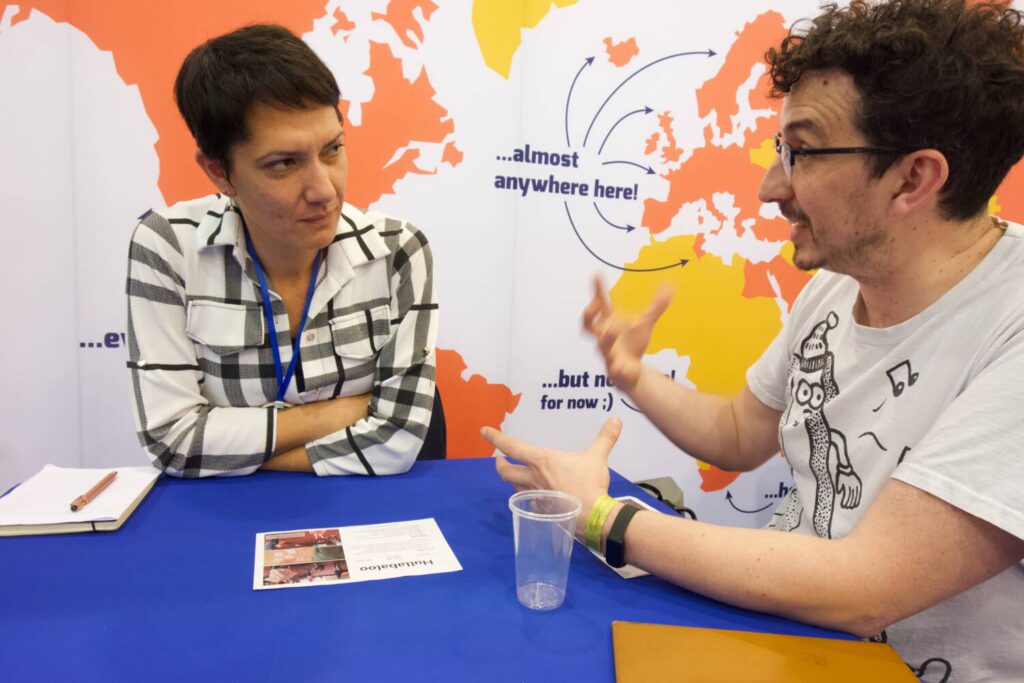
That’s what I was most impressed by over the course of the day. Jim’s ability to take a poor reception and turn it into something positive was wondrous. He took detailed notes throughout each meeting, following each rejection with a series of de facto follow-up questions that would better help him gauge potential interest in the future: “What sorts of games would you say you are looking for? What makes a game fit your brand?” He would meet each rejection in the present as an opportunity to find acceptance in the future. Indefatigable, old Jim, in situations that would have almost certainly taken the wind right out of many a sail.
“That’s why I have so many designs going at any one time. When I started designing, I would work obsessively on one game, but then it’s easy to get stuck, or discouraged. If you’ve got a bunch of games going, it’s easy to pivot to something else, to get excited by progress with a different idea.” The trick, it would seem, is to juggle multiple balls at once. If you drop one, you’re still juggling.
That’s not to say Jim is completely inured. The final pitch of the day was far and away the most brutal, with two representatives who seemed to take pleasure in being dismissive. It didn’t shake his confidence so much as it rattled him. “If that had been the first pitch I ever did,” he acknowledged after a bit of quiet, “I think that would have really discouraged me. But,” he added, temperamentally incapable of sitting under a rain cloud when he knows sunshine is over the next hill, “they were also extremely knowledgeable about their markets and their product line, and I quite liked that.”
Over the course of our day together, I found myself astonished by the gumption required to be a game designer. A life spent spray painting letter tiles or carving little wooden pigeons isn’t one you’d assume to be a source of endless negativity, and yet. To face rejection after rejection, to recognize that many of them have nothing to do with you, and to be able to walk up to the next booth with just as much of a smile and say, “Is there any chance you have anyone at the booth who is available to hear some pitches today?” is remarkable. Unpublished game designers are no different from any other kind of aspiring artist. You have to be relentless, you have to be confident, you have to believe in the work you are doing, and you have to know that the “No” you just got has no bearing whatsoever on the next response. It’s hard not to believe that all our lives would be better if we were able to approach them with that mindset.
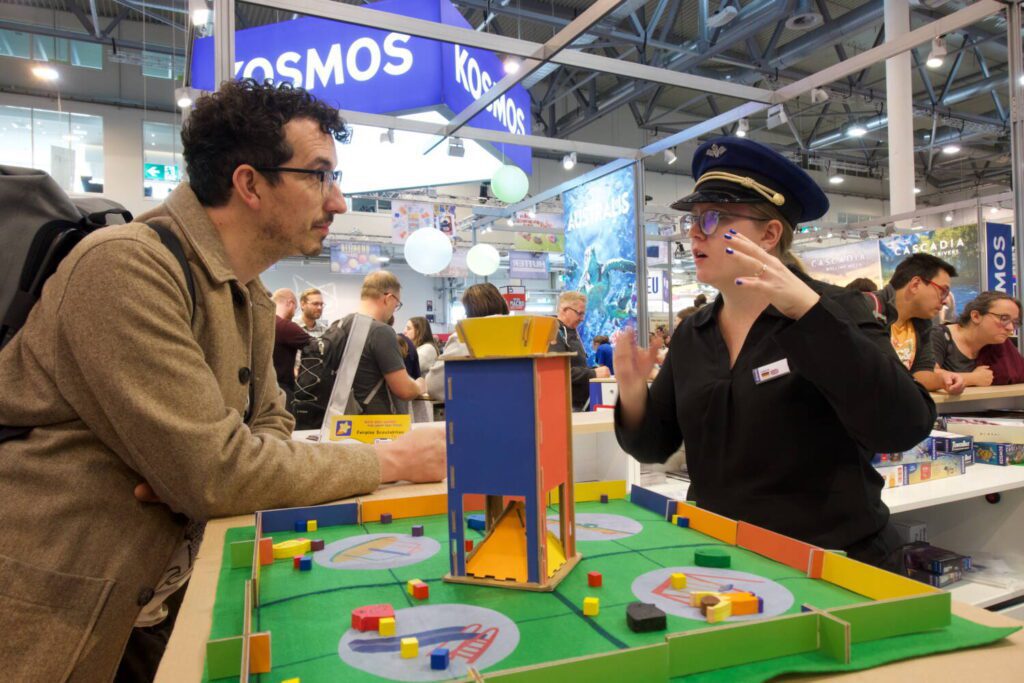



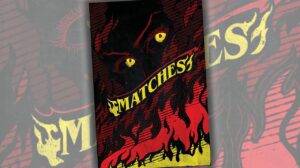
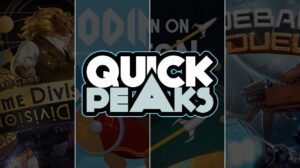

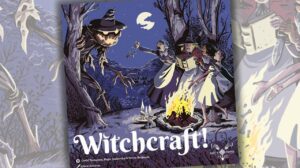




Really inspiring
I wish to publish my own games someday too